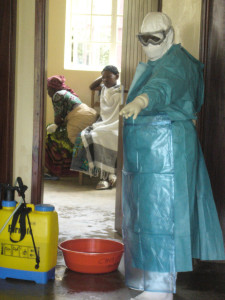Ebola Context
![]() The current outbreak in West Africa (first cases reported in March 2014) is the largest and most complex outbreak since Ebola was first discovered in 1976. There have been more cases and deaths in this outbreak than in all others combined. It has also spread between countries, starting in Guinea then spreading across land borders to Sierra Leone and Liberia, by air to Nigeria, and by land to Senegal and Mali. The most severely affected countries—Guinea, Sierra Leone and Liberia—have very weak health systems lacking in human and infrastructural resources, having only recently emerged from long periods of conflict and instability. On August 8, 2014, the WHO Director-General declared this outbreak a Public Health Emergency of International Concern.
The current outbreak in West Africa (first cases reported in March 2014) is the largest and most complex outbreak since Ebola was first discovered in 1976. There have been more cases and deaths in this outbreak than in all others combined. It has also spread between countries, starting in Guinea then spreading across land borders to Sierra Leone and Liberia, by air to Nigeria, and by land to Senegal and Mali. The most severely affected countries—Guinea, Sierra Leone and Liberia—have very weak health systems lacking in human and infrastructural resources, having only recently emerged from long periods of conflict and instability. On August 8, 2014, the WHO Director-General declared this outbreak a Public Health Emergency of International Concern.
A separate, unrelated Ebola outbreak began in Boende, Equateur, an isolated part of the Democratic Republic of Congo.
While KAP studies and other research efforts are still ongoing in the three primary Ebola countries, as of this writing (December 2014), a sample of the preliminary data from Liberia, Guinea and Sierra Leone shows that:
Rumors, misconceptions or inaccurate knowledge of Ebola transmission persist and there is a lack of trust of both national and foreign government assistance
Fear and panic lead to stigma and reduced health-seeking and substandard care practices.
Fear of death, of health care workers and of the disease by frontline HWs lead to either suboptimal care for patients or substandard implementation of protective measures.
Lack of understanding about Ebola is coupled with denial, mistrust and rejection of proposed public health interventions arising from misinterpretation of the cause of the new disease.
Public health interventions to reduce the spread of the disease (e.g., early isolation, no care for sick person, safe burials) are seen as highly intrusive and go against social/cultural patterns, which makes interventions difficult to accept.
There is a lack of experienced health care workers and capacities for rapid response.
There is high exposure to Ebola through household care and customary burial procedures.
There are close community ties and movement within and across borders, leading to difficulties in tracing and following up of contacts for the three countries.
Audience and Communication Analysis
Decisions affecting Ebola prevention and treatment are made at various levels: the individual, family, and community level; the health system level; and the society or policy level. It is helpful to look at the factors affecting Ebola prevention and treatment behaviors at each of these levels separately. Many sources were consulted to provide this global Ebola situation analysis.
Individual, Family, and Community Level
Common reasons for unsafe practices related to Ebola transmission are listed in the following table.
| Harmful practice | Common reasons for it |
| Unsafe burial practices |
|
| Close contact with bodily fluids of a sick Ebola patient |
|
| Poor hygiene and sanitation practices |
|
| Avoidance of ETUs or other health facilities |
|
| Stigma of Ebola survivors and HWs |
|
| Improper handling of Ebola patients by health care workers |
|
| Eating bushmeat |
|
Communication Strategy Guidance
View guidance on how and why to conduct a situation analysis.

